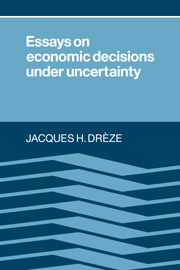Book contents
- Frontmatter
- Contents
- Acknowledgements
- Foreword
- I Decision-making under uncertainty: general theory
- II Markets and prices
- III Consumer decisions
- IV Producer decisions
- 11 Demand fluctuations, capacity utilisation and prices
- 12 Demand fluctuations, capacity utilisation and costs
- 13 On industry equilibrium under uncertainty
- V Theory of the firm
- IV Human capital and labour contracts
- VII Public decisions
- Index
12 - Demand fluctuations, capacity utilisation and costs
Published online by Cambridge University Press: 01 October 2009
- Frontmatter
- Contents
- Acknowledgements
- Foreword
- I Decision-making under uncertainty: general theory
- II Markets and prices
- III Consumer decisions
- IV Producer decisions
- 11 Demand fluctuations, capacity utilisation and prices
- 12 Demand fluctuations, capacity utilisation and costs
- 13 On industry equilibrium under uncertainty
- V Theory of the firm
- IV Human capital and labour contracts
- VII Public decisions
- Index
Summary
The impact of demand fluctuations on expected or average profits for a competitive firm was underlined by Walter Oi (1961), who showed the following: If a firm producing a single output under increasing marginal cost, equates (ex post) marginal cost to price, then expected (or average) profits increase with the variance of price. An obvious implication of this result is that increased uncertainty of demand, because it increases expected profits, will attract new firms in the industry if there exist entrepreneurs motivated by profit expectations. This implication was pursued in 1967 by Drèze and Gabszewicz (henceforth D–G), who considered an industry consisting of identical firms supplying a single commodity under demand uncertainty, and defined a competitive equilibrium by the condition that expected profits for each firm be zero.
Under specific assumptions (a cubic cost function, a random demand with known symmetric density, and zero-price elasticity), they derived the following propositions:
In competitive equilibrium there is an optimum number of firms, each of which is operating with excess capacity on the average.
In competitive equilibrium the expected price is less than minimum average cost, and could not be reduced further without causing expected profits to become negative.
In competitive equilibrium expected marginal cost is equal to expected average cost when and only when the expectations are weighted by quantities.
Under price rigidity a price equal to expected marginal cost (unweighted) exceeds minimum average cost when expected profits are zero.
- Type
- Chapter
- Information
- Essays on Economic Decisions under Uncertainty , pp. 234 - 249Publisher: Cambridge University PressPrint publication year: 1987

